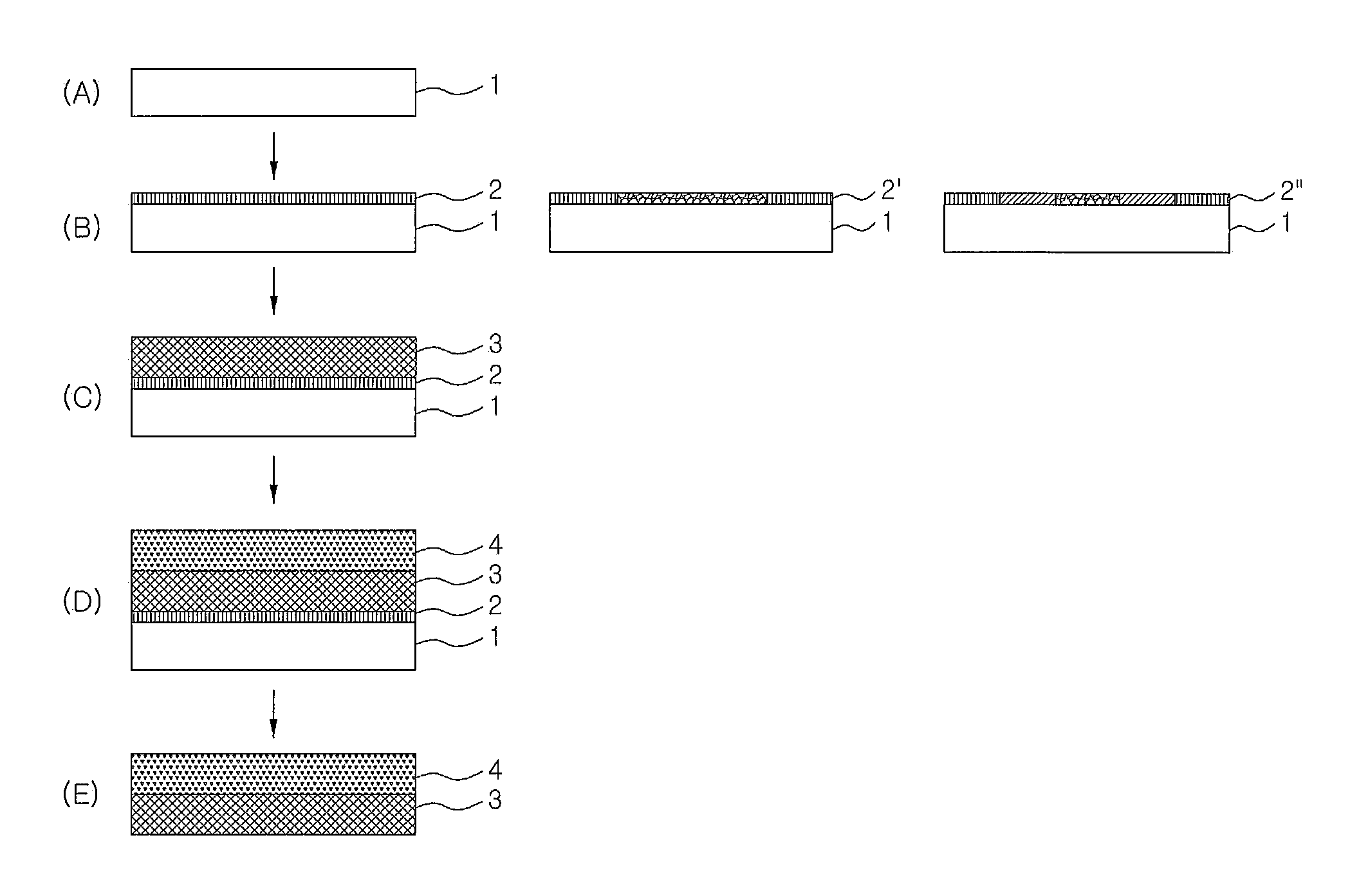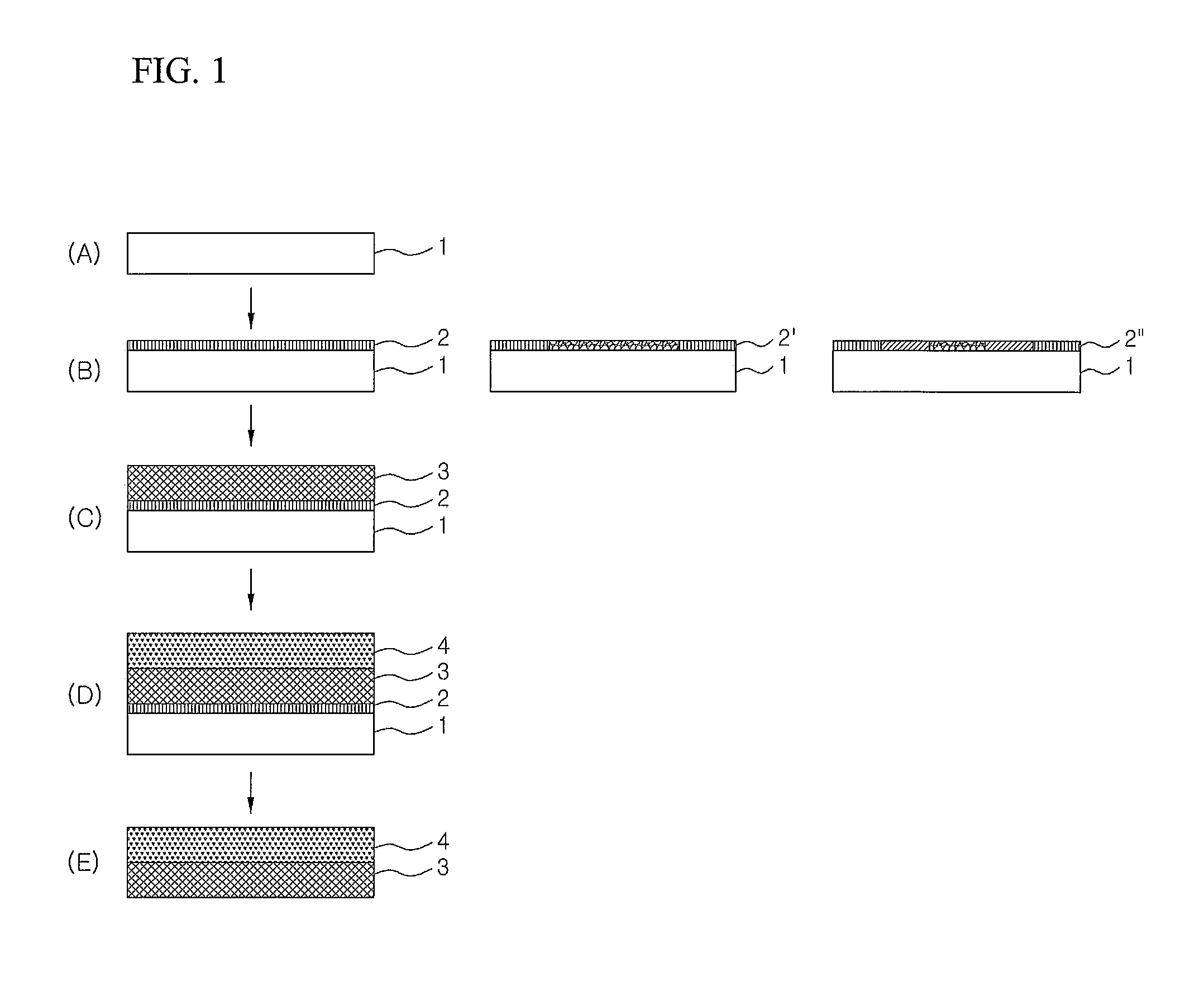Fabrication Method of Flexible Devices
a technology of flexible devices and fabrication methods, which is applied in the direction of semiconductor devices, electrical/magnetic/electromagnetic heating, electrical apparatus, etc., can solve the problems of difficult handling of the fabrication process, insufficient research into reliable flexible device fabrication processes for commercialization and mass production, and complicating the fabrication process. , to achieve the effect of easy separation of plastic substrates
- Summary
- Abstract
- Description
- Claims
- Application Information
AI Technical Summary
Benefits of technology
Problems solved by technology
Method used
Image
Examples
example 1
[0030]A glass plate was cut to a size of 10 cm×10 cm, and then subjected to oxygen plasma treatment. Subsequently, the center region of the glass plate except the four sides thereof having a width of 1 cm was deposited with 1H,1H,2H,2H-heptadecafluorodecyltrimethoxysilane. On the glass plate thus surface-treated, a 50 μM-thick glass fabric (E-glass, Nittobo, Japan) was disposed, and a siloxane resin (MD or HMD Hybrimer, KAIST, Korea) having methacryl groups and phenyl groups was coated thereon and thus impregnated therein. While pressure was applied thereto, 365 nm UV was irradiated for 5 min in a nitrogen atmosphere, thus forming a glass-fiber reinforced plastic substrate film on the carrier plate. On the glass-fiber reinforced plastic substrate film formed on the surface-treated glass plate, atomic layer deposition (ALD) and radio frequency (RF) sputtering were performed at 150° C., thus fabricating an oxide semiconductor thin film transistor. Thereafter, the glass-fiber reinforce...
example 2
[0031]A glass plate was cut to a size of 10 cm×10 cm, and then subjected to oxygen plasma treatment. Subsequently, the glass plate was surface-treated in such a manner that the center region of the glass plate except the four sides thereof having a width of 1 cm was coated with a siloxane resin (ED Hybrimer, KAIST, Korea) having epoxy groups and phenyl groups to form a thin film. Subsequently, two 25 μm-thick sheets of glass fabric (E-glass, Nittobo, Japan) were disposed on the surface-treated glass plate, and a siloxane resin (MD or HMD Hybrimer, KAIST, Korea) having methacryl groups and phenyl groups was coated thereon and thus impregnated therein. While pressure was applied thereto, 365 nm UV was irradiated for 5 min in a nitrogen atmosphere, thus forming a glass-fiber reinforced plastic substrate film on the carrier plate. ALD and RF sputtering were performed at 150° C. on the glass-fiber reinforced plastic substrate film formed on the surface-treated glass plate, thus fabricati...
example 3
[0032]A glass plate was cut to a size of 10 cm×10 cm, and then subjected to oxygen plasma treatment. Subsequently, the glass plate was surface-treated in such a manner that four sides of the glass plate having a width of 1 cm were coated with a polydophamine aqueous solution resin to form a thin film and the center region thereof was deposited with 1H,1H,2H,2H-heptadecafluorodecyltrimethoxysilane. On the glass plate thus surface-treated, two 25 μm-thick sheets of glass fabric (E-glass, Nittobo, Japan) were disposed, and a siloxane resin (ED Hybrimer, KAIST, Korea) having epoxy groups and phenyl groups was coated thereon and thus impregnated therein. 365 nm UV was then irradiated for 5 min, thus forming a glass-fiber reinforced plastic substrate film on the carrier plate. ALD and RF sputtering were performed at 150° C. on the glass-fiber reinforced plastic substrate film formed on the surface-treated glass plate, thus fabricating an oxide semiconductor thin film transistor. Thereafte...
PUM
| Property | Measurement | Unit |
|---|---|---|
| size | aaaaa | aaaaa |
| width | aaaaa | aaaaa |
| transparent | aaaaa | aaaaa |
Abstract
Description
Claims
Application Information
 Login to View More
Login to View More - R&D
- Intellectual Property
- Life Sciences
- Materials
- Tech Scout
- Unparalleled Data Quality
- Higher Quality Content
- 60% Fewer Hallucinations
Browse by: Latest US Patents, China's latest patents, Technical Efficacy Thesaurus, Application Domain, Technology Topic, Popular Technical Reports.
© 2025 PatSnap. All rights reserved.Legal|Privacy policy|Modern Slavery Act Transparency Statement|Sitemap|About US| Contact US: help@patsnap.com


